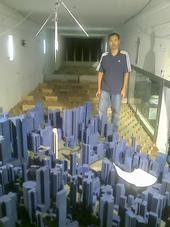Highlight
IGERT Trainee Study Connections of Indoor and Outdoor Environments
Achievement/Results
The UTest house, built and instrumented with first-year funds from National Science Foundation’s (NSF) Integrative Graduate Education and Research Traineeship (IGERT) program in Indoor Environmental Science and Engineering at The University of Texas (UT), provided the IGERT trainees with the unique opportunity to study transport of air and contaminants between indoor and outdoor spaces. Three IGERT trainees/affiliates, including one alumnus, have been involved in characterizing the connection between indoor and outdoor environments.
One of the PhD research objectives of IGERT Trainee James Lo is to investigate and develop a reliable method to model indoor and outdoor airflow in buildings with natural ventilation, one strategy being used to provide ventilation without expending energy for fans. He is conducting full-scale experiments in the UTest House to characterize parameters that affect wind-driven ventilation. This work includes measuring the effects that wind has on overall airflow rate and pollutant transport in naturally ventilated buildings and modeling the impacts that wind unsteadiness has on air and pollutant flows. Also, last summer James spent his IGERT internship at CPP Wind Engineering and Air Quality Consultants Company, which is the leading institution for applied wind engineering studies in U.S. The CPP researchers expressed great interest in James’ work and provided him with an opportunity to expend his research by using their state-of-the-art wind tunnel facility. James collaborated with several CPP researchers during his three-month period, including Scot Waye, the first IGERT trainee to graduate from the Indoor Environmental Science and Engineering program. They conducted a wide range of wind tunnel experiments using a scaled down model of the UTest House to systematically investigate the impact of wind orientation and turbulence on indoor-outdoor ventilation airflow rates. The final results of the study should improve the accuracy of natural ventilation models when applied in air quality analyses.
Another IGERT Trainee, Brent Stephens, is using the UTest House to investigate the transport of outdoor particulate matter and reactive gases (e.g. ozone) into buildings in relation to both building air leakage characteristics and building envelope materials. This research is important from a human exposure perspective, as well as for accurate risk assessments during extraordinary events such as wildfires or the recent nuclear contamination in Northern Japan. The goal is to develop a methodology that infers how efficiently outdoor particles and ozone penetrate into buildings (a time-consuming and difficult experiment to perform in the field) from easy and ubiquitous blower door test results and building envelope material characteristics. Furthermore, because current techniques for measuring air infiltration rates are typically time-consuming and invasive, Brent is developing a methodology that uses simple measurements of indoor-outdoor pressure differences to predict air infiltration rates. These investigations will allow researchers to better estimate indoor exposures to outdoor pollutants, which should allow epidemiological studies to adopt more specific population exposures from ambient pollutant data. Additionally, the methods may be used to assess changes in the ability of a building to protect indoor environments from outdoor pollution after undergoing weatherization retrofit measures. While James’ work addresses natural ventilation, Brent’s research focuses primarily on infiltration. However, both studies provide models or methods that characterize transport phenomena between indoor and outdoor environments. Both studies advance existing ventilation models and improve the accuracy of the models when applied in indoor air quality analyses.
Address Goals
These research activities involve discovery using well-designed experiments based on fundamental knowledge of fluid dynamics, particle transport and pollutant reaction with building materials. The hypotheses related to airflow due to natural ventilation and infiltration and ozone and particle transport are formed and tested using the experiments in the UTest House and the CPP wind tunnel. In this process models and methods are developed for use by other researchers and engineers. These activities also have a significant learning component, as students learn about experimental methods, engineering analysis, fluid dynamics, aerosol science, and surface chemistry in the discovery process. Also, several undergraduate students have been involved in experiments with the UTest house and most of them decided to pursue graduate school programs at UT and other universities.






